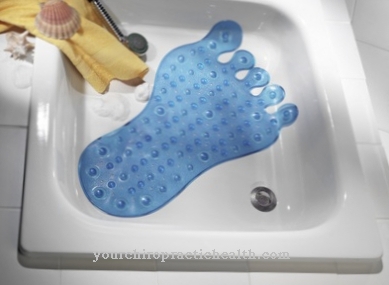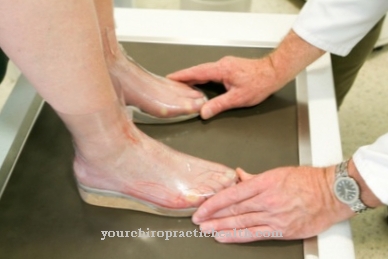As Knee prosthesis partial or complete replacement of the knee joint is called. It is used in the event of injuries or severe knee wear.
What is a knee prosthesis?

A knee prosthesis is an implanted prosthesis that either partially or completely replaces the human knee joint. The Knee endoprosthesis or Knee joint prosthesis is used as part of an operation and is used to restore joint stability. In addition, the patient can move painlessly again. A knee prosthesis is used when the knee joint is injured or worn.
After the hip prosthesis, the knee prosthesis is the second most frequently used joint endoprosthesis in Germany. Around 175,000 first operations are performed in this country every year. In most cases, people over the age of 70 will receive a prosthetic knee.
A knee prosthesis is usually only implanted if conservative treatments such as drug therapy or physiotherapy do not have the desired effect.
Shapes, types & types
The first knee prostheses came into use in the early 1970s. There are now three different types of prostheses. These are unilateral surface replacements, also called sled prostheses, complete surface replacements and complete joint replacements with axis guidance.
Each type of prosthesis includes many different models. Their selection is based on the individual requirements of the patient, such as the size and shape of the knee, physical activities and body weight. In order to insert the correct type of prosthesis, the surgeon carries out an X-ray examination beforehand. In addition, a comparison with trial prostheses is possible during the procedure.
A one-sided replacement of the surface is called a sled prosthesis. It is used to exchange the inside or outside of the knee joint. The remaining parts of the knee are still intact. The sled prosthesis is placed on either the outer or the inner thigh roll. A metal lower part and a plastic block are attached to the other side of the knee joint on the shin plateau. When the knee moves, the knee prosthesis can slide back and forth on the block.
A complete resurfacing is a knee prosthesis that serves as a replacement for multiple knee joint structures. The ligaments that are responsible for the axis guidance of the knee are retained. This form of prosthesis is one of the most commonly used types.
If not only the cartilage and bone structures but also the ligaments were affected by the knee damage, a complete joint replacement with axis guidance is used. The knee prosthesis also takes care of the axial guidance, which stabilizes the knee in the longitudinal axis, which counteracts any displacement in the lateral direction. This type of prosthesis is equipped with a support in the middle of the joint so that the lower leg bone cannot move laterally in relation to the thigh bone.
Structure & functionality
The construction of a knee prosthesis consists of three components, which must be replaced as part of the knee implantation. These are the tibia component (shin part), the femoral component (thigh part) and a plastic support on the shin part.
In most cases, the femoral component is composed of a cobalt-chromium alloy. It serves as a replacement for the worn surface of the cartilage of the femur roll. The tibial component is mostly made of titanium. Its function is to replace the worn joint sections on the tibial head. On the shin component there is a plastic inlay made of polyethylene. This material has the property of being resistant to abrasion and acting as a sliding surface.
In order for the knee prosthesis to remain stable for as long as possible, certain criteria are required for the materials. This primarily includes corrosion resistance and load capacity. So there must be no abrasion when the prosthesis sliding pairs rub against one another. In addition, intolerance reactions through the exogenous substances must be prevented. For this reason, special plastics, metals and ceramics are used as materials for a knee prosthesis.
You can find your medication here
➔ Medicines for painMedical & health benefits
The health benefits of a knee prosthesis are considered to be high. The use of an artificial knee joint makes sense if the joint functions are impaired or the person affected is suffering from severe pain. The most common indications for a knee endoprosthesis are osteoarthritis, inflammation of the knee joint such as rheumatism, injuries, overloads and misalignments.
Depending on how severe the disease is, the doctor decides which type of prosthesis is best suited to the patient. However, fitting a knee prosthesis is not without its risks. Around 5.5 percent of all patients experience unexpected complications. This mainly includes bacterial infections, the occurrence of a thrombosis (blood clot) or the dislocation of individual parts of the prosthesis. Sometimes the knee prosthesis loosens prematurely, which can lead to pain, leg misalignment or instability. However, these complications only show up in rare cases.
Basically, the prognosis after the insertion of a knee prosthesis is positive. The patient has more mobility and feels significantly less pain, which significantly increases his quality of life. The durability of a knee prosthesis is on average 10 to 15 years. To prevent the knee prosthesis from loosening, the patient should avoid joint-shaking sports, lifting heavy loads and being overweight.

























.jpg)


